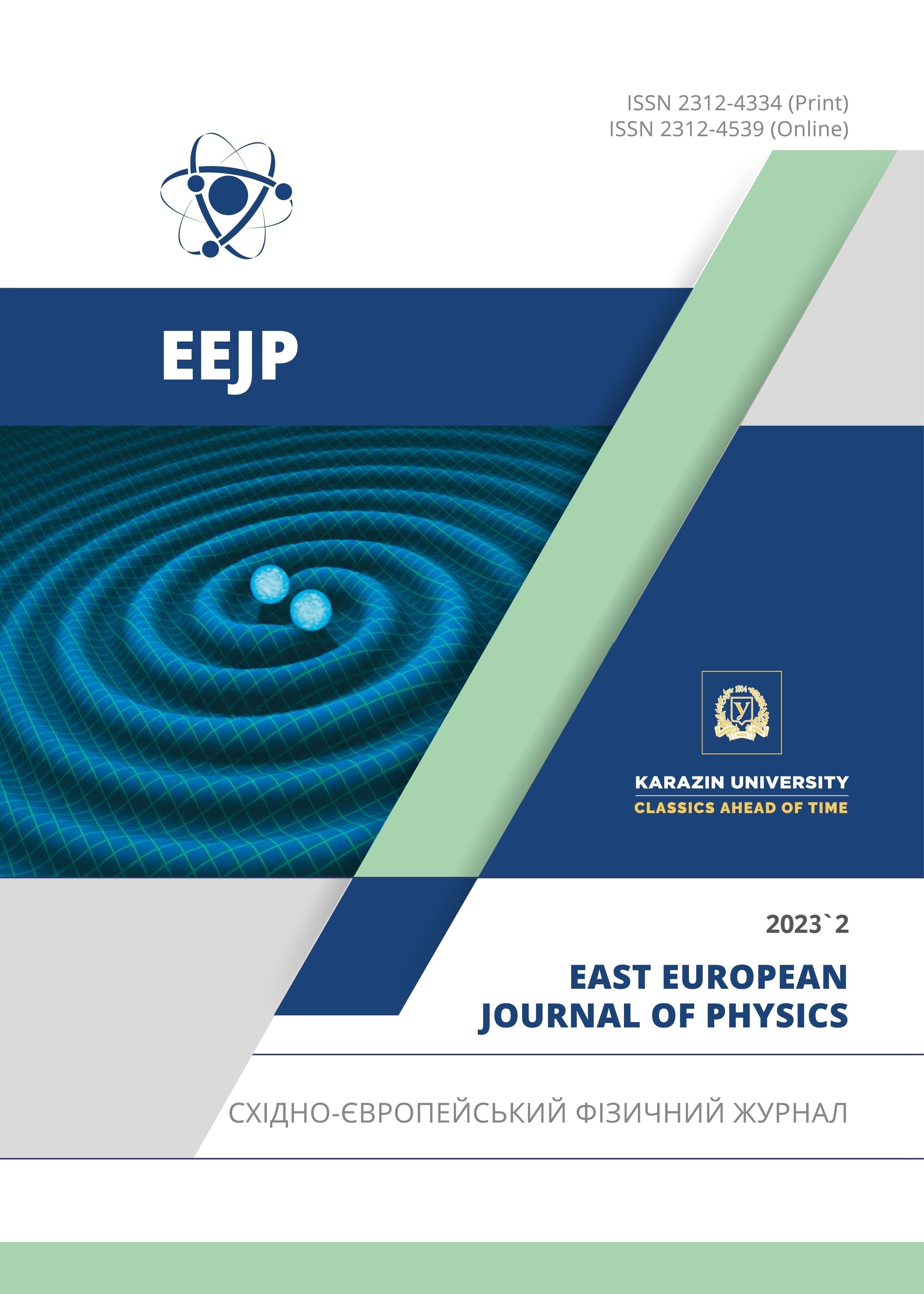Physicochemical Characteristics for Fen (n = 2–10) Cluster by Density Functional Theory
Abstract
The In this work, we present a theoretical study on the equilibrium geometry and the energetic, electronic and magnetic properties of Fen (n = 2–10) based on the use of density functional theory (DFT). The results are obtained using Both Generalized Gradient Approximation according to the scheme described by Perdew-Burke-Ernzerhof (GGA-PBE). More stable structures obtained compared to other isomers have not been previously found. It is shown by the results calculated as the calculated fragmentation energy, and the second-order energy difference that Fen (n = 7,8,9) clusters are more stable than the other cluster sizes. The calculated magnetic properties of the most stable clusters display varying magnetic torque between values 3.00 μB and 3.35 μB, except for the Fe10 cluster, which takes the upper value 3.38 μB. These results are very important for experimental experts who are active in designing new nanocatalysis systems in the physical and chemical fields.
Downloads
References
J.B. Haun, T-J. Yoon, H. Lee, and R. Weissleder, “Magnetic nanoparticle biosensors,”WIREs Nanomedicine and Nanobiotechnology. 2(3), 291-304 (2010). https://doi.org/10.1002/wnan.84
H. Lee, T-J. Yoon, and R. Weissleder, “Ultrasensitive detection of bacteria using core-shell nanoparticles and an NMR-filter system,” Angew. Chem. Int. Ed.48(31), 5657-5660 (2009). https://doi.org/10.1002/anie.200901791
E.I. Galanzha, E.V. Shashkov, T. Kelly, J-W. Kim, L. Yang, and V.P. Zharov, “In vivo magnetic enrichment and multiplex photoacoustic detection of circulating tumor cells,” Nat. Nano. 4(12), 855-860 (2009). https://doi.org/10.1038/nnano.2009.333
M.D. Morse, “Clusters of transition-metal atoms,” Chem. Rev. 86(6), 1049-1109 (1986). https://doi.org/10.1021/cr00076a005
J.N. Harvey, “DFT computation of relative spin-state energetic of transition metal compounds,” Struct. Bond. 112, 151-184 (2004). https://doi.org/10.1007/b97939
C.J. Cramer, and D.G. Thrular, “Density functional theory for transition metals and transition metal chemistry,” Phys. Chem. Chem.Phys. 11, 10757-10816 (2009). https://doi.org/10.1039/b907148b
M. Castro, “The role of the Jahn-Teller distortions on the structural, binding, and magnetic properties of small Fen clusters n≤7,” International J. Quantum. Chem. 64(2), 223-230 (1997). https://doi.org/10.1002/(SICI)1097-461X(1997)64:2<223::AID-QUA9>3.0.CO;2-Y
Ž. Šljivančanin, and A. Pasquarello, “Supported Fe nanoclusters: evolution of magnetic properties with cluster size,” Phys. Rev. Lett. 90(24), 247202-247204 (2003). https://doi.org/10.1103/PhysRevLett.90.247202
T. Oda, A. Pasquarello, and R. Car, “Fully unconstrained approach to noncollinear magnetism: application to small Fe clusters,” Phys.Rev. Lett. 80(16), 3622-2625 (1998).https://doi.org/10.1007/s00894-012-1395-2
C. Köhler, G. Seifert, and T. Frauenheim, “Density functional based calculations for Fen (n≤32),” Chem. Phys. 309(1), 23 31 (2005). https://doi.org/10.1016/J.CHEMPHYS.2004.03.034
F.S. Ham, “The Jahn-Teller effect: a retrospective view,” J. Luminescence, 85(4), 193-197 (2000). https://doi.org/10.1016/S0022-2313(99)00187-8
P. Ordejón, E. Artacho, and J.M. Soler, “Self-consistent order-N density-functional calculations for very large systems,” Physical Review B, 53(16), 10441 (1996). https://doi.org/10.1103/PhysRevB.53.R10441
J.P. Perdew, and A. Zunger, “Self-interaction correction to density-functional approximations for many-electron systems,” Physical. Review B, 23(10), 5048 (1981). https://doi.org/10.1103/PhysRevB.23.5048
J.P. Perdew, K. Burke, and M. Ernzerhof, “Generalized gradient approximation made simple,” Physical review letters. 77(18), 3865 (1996). https://doi.org/10.1103/PhysRevLett.77.3865
J.M. Soler, “The SIESTA method for ab initio order-N materials simulation,” Journal of Physics. Condensed Matter. 14(11), 2745 (2002). https://doi.org/10.1088/0953-8984/14/11/302
N. Troullier, and J.L. Martins, “Efficient pseudopotentials for plane-wave calculations,” Physical Review B, 43(3), 1993 (1991). https://doi.org/10.1103/PhysRevB.43.1993
B.V. Reddy, S.N. Khanna, and S.C. Deevi, “Electronic structure and magnetism in (FeAl)n(n⩽6) clusters,” Chem. Phys. Lett. 333, 465-470 (2001). https://doi.org/10.1016/S0009-2614(00)01393-2
S. Dhar, and N.R. Kestner,“Electronic structure of the Fe2 molecule in the local-spin-density approximation,” Phys. Rev. A, 38, 1111-1119 (1988). https://doi.org/10.1103/physreva.38.1111
J.L. Chen, C.S. Wang, K.A. Jackson, and M.R. Pederson, “Theory of magnetic and structural ordering in iron clusters,” Phys. Rev. B, 44, 6558-6561 (1991). https://doi.org/10.1103/PhysRevB.44.6558
P.A. Montano, and G.K. Shenoy, “EXAFS study of iron monomers and dimers isolated in solid argon,” Solid State Commun. 35, 53-56 (1980). https://doi.org/10.1016/0038-1098(80)90769-3
H. Purdum, P.A. Montano, G.K. Shenoy, and T. Morrison,” Extended-x-ray-absorption-fine-structure study of small Fe molecules isolated in solid neon,” Phys. Rev B, 25, 4412-4417 (1982). https://doi.org/10.1103/PhysRevB.25.4412
C-S. Keitel, and M.J. Seminario,” Structure and energetics of small iron clusters,” J. Mol. Model. 18(9), 4043 4045 (2012). https://doi.org/10.1007/s00894-012-1395-2
X.G. Gong, and Q.Q. Zheng, “Local spin-density electronic structures and magnetic properties of small iron clusters,” J. Phys. Condensed. Matter. 7(12), 2421-2428 (1995). https://doi.org/10.1088/0953-8984/7/12/006
S. Chrétien, and D.R. Salahub, “Kohn-Sham density-functional study of low-lying states of the iron clusters Fen +/Fen/Fen - (n01−4),” Phys Rev. B, 66 (15), 155401-155412 (2002). https://doi.org/10.1103/PhysRevB.66.155425
M. Castro, and D.R. Salahub, “Density-functional calculations for small iron clusters: Fen, Fen +, and Fen - for n≤5,” Phys. Rev. B, 49(17), 11842-11852 (1994). https://doi.org/10.1103/PhysRevB.49.11842
R. G. Pearson, Chemical hardness, (Wiley-VCH Verlag GmbH, Weinheim, 1997).
O. Diéguez, M.M.G. Alemany, C. Rey, P. Ordejón, and L.J. Gallego, “Density-functional calculations of the structures, binding energies, and magnetic moments of Fe clusters with 2 to 17 atoms,” Phys Rev. B, 63(20), 205407-205406 (2001). https://doi.org/10.1103/PhysRevB.63.205407
G. Rollmann, P. Entel, and S. Sahoo, “Competing structural and magnetic effects in small iron clusters,” Comput. Mater. Sci. 35(3), 275-278 (2006). https://doi.org/10.1016/j.commatsci.2004.09.059
C. Köhler, G. Seifert, and T. Frauenheim, “Density functional based calculations for Fen (n≤32),” Chem. Phys. 309(1), 23-31 (2005). https://doi.org/10.1016/J.CHEMPHYS.2004.03.034
Copyright (c) 2023 Yamina Benkrima, Djamel Belfennache, Radhia Yekhlef, Mohammed Elbar Soudani, Abdelkader Souigat, Yahia Achour

This work is licensed under a Creative Commons Attribution 4.0 International License.
Authors who publish with this journal agree to the following terms:
- Authors retain copyright and grant the journal right of first publication with the work simultaneously licensed under a Creative Commons Attribution License that allows others to share the work with an acknowledgment of the work's authorship and initial publication in this journal.
- Authors are able to enter into separate, additional contractual arrangements for the non-exclusive distribution of the journal's published version of the work (e.g., post it to an institutional repository or publish it in a book), with an acknowledgment of its initial publication in this journal.
- Authors are permitted and encouraged to post their work online (e.g., in institutional repositories or on their website) prior to and during the submission process, as it can lead to productive exchanges, as well as earlier and greater citation of published work (See The Effect of Open Access).








